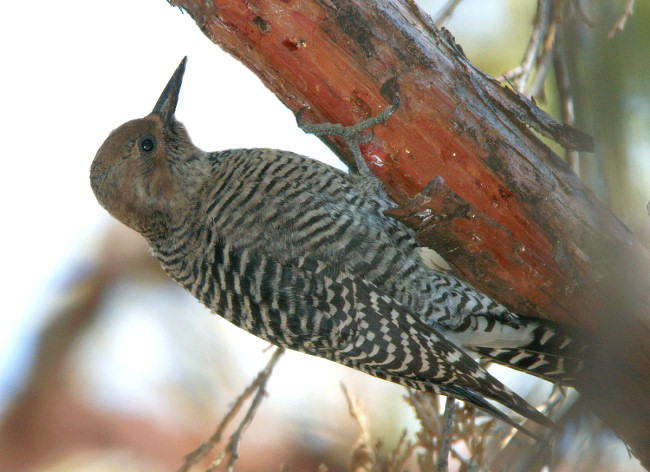
Location: Cuyamaca State Park, Cuyamaca, CA
Date: 2006-12-09
Lens: Canon 600mm IS F4 + 1.4x II Converter

 Williamson's Sapsucker
Sphyrapicus thyroideus
Williamson's Sapsucker
Sphyrapicus thyroideus
 Description
DescriptionThe dramatic difference in appearance between the male and female Williamson's sapsucker caused confusion with early naturalists who considered the two birds were separate species. The male was called the Williamson's sapsucker, while the female was called a Black-breasted Woodpecker. This sapsucker is named after Robert Williamson, a topographical engineer who led surveying expeditions throughout the western United States. The sapsucker primarily feeds by drilling concentric rings of shallow sap wells in a confier tree. It also feeds on ants trapped in the sap wells.
General: 9 inches in length.
Male:Black head, breast, back, wings, and tail. Red throat patch. Two thin white disconnected head stripes, one above the eye and one below, extending from bill to nape. Black bill. Bright yellow belly. Black and white barring on flanks. White barring on flight feathers. Large white patch on wing coverts. White rump. White barring on centralmost and outermost tail retricies. Immature male has a white throat, not red.
Female: Pale brown head, breast and back. Black barring on back, breast and sides. Black bill. Dark wings with white barring and spots. Yellow belly. White rump. White barring on centralmost and outermost tail retricies.
Open coniferous forests. Breeds at middle to high elevations, generally from 4,900–10,500 feet. Nests at lower elevations (from 2,800–4,250 feet) at the northern edge of its range.
 Nesting
Nesting3-7 white eggs. The eggs have a 12-14 day incubation period. Fledging occurs in 21-28 days. The nest is a small bed of wood chips and shavings placed at the bottom of a cavity excavated in a pine or fir snag. The same cavity is not reused from year to year. This species does not regurgitate food to its young. Instead, parents carry food, mostly ants, in their throat, mouth and bill to the young.